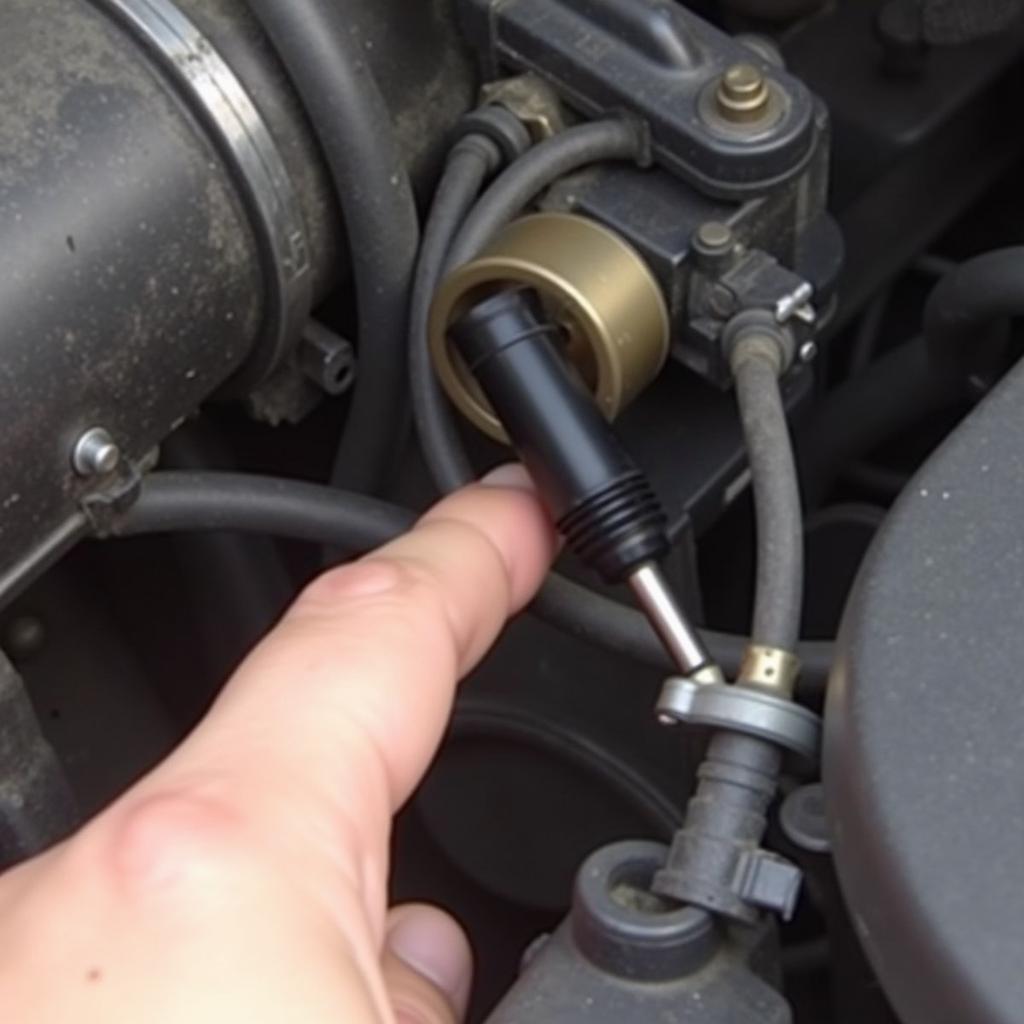You’re driving your Hyundai Santa Fe, and suddenly, the check engine light pops up on your dashboard. You connect your OBD2 scanner and find code P0131 staring back at you. Don’t panic! This article will break down everything you need to know about OBD2 code P0131 in your Hyundai Santa Fe, from its meaning to possible causes and solutions.
Understanding OBD2 Code P0131
OBD2 code P0131 indicates a problem with your oxygen sensor’s circuit voltage. Specifically, it refers to Bank 1 Sensor 1, which is the oxygen sensor located before the catalytic converter on the side of the engine with cylinder #1. The oxygen sensor plays a crucial role in monitoring the amount of oxygen in your exhaust gases, sending this information to the engine control unit (ECU) to adjust the air-fuel mixture for optimal performance and emissions control.
When the oxygen sensor circuit voltage remains low for an extended period, the ECU detects a problem and triggers the P0131 code, turning on the check engine light.
Common Causes of P0131 in Hyundai Santa Fe
Several factors can cause the P0131 code in your Hyundai Santa Fe:
-
Faulty Oxygen Sensor (Bank 1, Sensor 1): The most common culprit is a malfunctioning oxygen sensor that can no longer accurately measure oxygen levels in the exhaust.
-
Wiring Problems: Damaged, corroded, or loose wiring in the oxygen sensor circuit can disrupt the voltage signal, leading to a P0131 code.
-
Exhaust Leaks: Leaks in the exhaust manifold, exhaust pipes, or other components before the oxygen sensor can introduce outside air, confusing the sensor readings.
-
Vacuum Leaks: Similar to exhaust leaks, vacuum leaks can disrupt the air-fuel ratio, indirectly affecting oxygen sensor readings.
-
Faulty Fuel Pressure Regulator: A malfunctioning fuel pressure regulator can cause an excessively rich fuel mixture, impacting oxygen sensor readings.
-
Faulty ECU: While rare, a faulty ECU can misinterpret sensor data, triggering inaccurate error codes, including P0131.
Symptoms of OBD2 Code P0131
While the check engine light is the most obvious symptom, you may experience other issues:
-
Decreased Fuel Economy: A malfunctioning oxygen sensor can cause your engine to run inefficiently, leading to increased fuel consumption.
-
Rough Engine Idle: The engine may idle roughly or stall due to an improper air-fuel mixture caused by inaccurate oxygen sensor readings.
-
Reduced Engine Performance: You might notice a decrease in engine power and acceleration, especially under heavy loads.
-
Failed Emissions Test: A P0131 code can cause your vehicle to fail emissions testing due to increased exhaust emissions.
Diagnosing and Fixing P0131 in Your Hyundai Santa Fe
Before replacing any parts, it’s essential to diagnose the root cause of the problem accurately. Here’s a step-by-step guide:
-
Read the OBD2 Codes: Connect your OBD2 scanner and retrieve all stored codes, including any pending codes. This information can provide valuable clues for diagnosing the issue.
-
Inspect the Oxygen Sensor: Visually inspect the oxygen sensor and its wiring for any signs of damage, corrosion, or loose connections.
-
Check for Exhaust Leaks: Listen for any hissing sounds coming from the exhaust system, indicating a potential leak. You can also use a smoke machine to detect leaks.
-
Inspect Vacuum Lines: Look for cracked, disconnected, or damaged vacuum lines.
-
Test the Oxygen Sensor Voltage: Using a multimeter, check the oxygen sensor’s voltage output. A healthy sensor should fluctuate between 0.1 and 0.9 volts.
- Consider Professional Help: If you’re uncomfortable with DIY diagnostics or repairs, it’s best to consult a qualified mechanic, especially if the issue is not easily identifiable.
Fixing the P0131 Code
-
Replace the Oxygen Sensor: If the sensor is faulty, replacing it is the most effective solution.
-
Repair Wiring Issues: Repair or replace any damaged or corroded wiring in the oxygen sensor circuit.
-
Fix Exhaust Leaks: Address any exhaust leaks by tightening connections, replacing gaskets, or repairing damaged components.
-
Repair Vacuum Leaks: Replace or repair any damaged or loose vacuum lines.
-
Replace Faulty Components: If other components like the fuel pressure regulator are identified as faulty, replace them accordingly.
Frequently Asked Questions About P0131 in Hyundai Santa Fe
Can I drive with a P0131 code?
It’s not recommended to drive for extended periods with a P0131 code as it can lead to reduced fuel economy, engine damage, and even catalytic converter failure.
How much does it cost to fix a P0131 code?
The cost varies depending on the root cause. Replacing an oxygen sensor can range from $100 to $300, while fixing wiring issues or exhaust leaks may cost less.
How long does it take to replace an oxygen sensor?
Replacing an oxygen sensor is a relatively straightforward procedure, typically taking less than an hour.
Can a bad oxygen sensor damage my engine?
Yes, a malfunctioning oxygen sensor can lead to an improper air-fuel mixture, potentially damaging the catalytic converter and other engine components.
How often should I replace my oxygen sensors?
Oxygen sensors have a limited lifespan and should be replaced according to your Hyundai Santa Fe’s maintenance schedule, typically between 60,000 and 90,000 miles.
Conclusion
Addressing the OBD2 code P0131 in your Hyundai Santa Fe is crucial for maintaining optimal engine performance, fuel efficiency, and emissions control. By understanding the code’s meaning, potential causes, and solutions outlined in this article, you can confidently diagnose and resolve the issue, keeping your Santa Fe running smoothly. If you’re unsure about any aspect of the diagnosis or repair process, don’t hesitate to seek assistance from a qualified mechanic.
Need help with your OBD2 scanner or diagnosing car problems? Contact our team of experts via WhatsApp: +1(641)206-8880 or Email: [email protected]. We offer 24/7 support to help you get back on the road.


